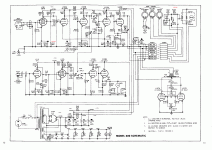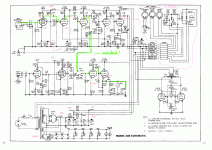Hi,
I'm sorting out an Ampex 600 valve preamp. B+voltage supply is quite a bit higher than the schematic indicates. I've attached the schematic and added the voltages that I've taken. Also there are a couple of components missing - a resistor that is part of a voltage divider on the screen of the first stage (R103) and also R202 which is actually on a different part of the tape machine that no longer exists (in fact that whole top right section is therefore absent).
Any ideas why the voltages are higher? I checked the plate and cathode resistors and they are not too far out from indicated values.
Cheers
Tom
I'm sorting out an Ampex 600 valve preamp. B+voltage supply is quite a bit higher than the schematic indicates. I've attached the schematic and added the voltages that I've taken. Also there are a couple of components missing - a resistor that is part of a voltage divider on the screen of the first stage (R103) and also R202 which is actually on a different part of the tape machine that no longer exists (in fact that whole top right section is therefore absent).
Any ideas why the voltages are higher? I checked the plate and cathode resistors and they are not too far out from indicated values.
Cheers
Tom
Attachments
What sort of meter are you using to do the measurements? An analog meter with a sensitivity of 20K/volt was recommended - the reason this is stated is that they load down the circuit measured to some extent.
I imagine you are using a modern DMM with much higher effective input resistance, so your readings will be much closer to the actual circuit operating voltages than would be the case with the meter specified. They will also be higher than the values measured by a meter with the recommended listed sensitivity.
I imagine you are using a modern DMM with much higher effective input resistance, so your readings will be much closer to the actual circuit operating voltages than would be the case with the meter specified. They will also be higher than the values measured by a meter with the recommended listed sensitivity.
Attachments
R202 compensates for not being in REC mode. We expect all voltages to be higher; unless you can jam it into REC for testing.
Modern-made 5Y3s can have far less voltage drop than those made long ago. Today's usual "5Y3" is a Russian type, similar, but improved... improved unless you were counting on the old sag. This has been an issue in many Fender amplifiers.
If you are not going to use this as a recording amp, I would get a bag of 100Ω 10W resistors, series, between 5Y3 and first cap. And a jumper-clip wire. Carefully short-out each resistor in the string until you get close to stock voltages. No, it is not OCD critical, everything may be +/-20%. Add-up how many Ohms you end up with. One 10 Watt part of that Ohms should work.
Modern-made 5Y3s can have far less voltage drop than those made long ago. Today's usual "5Y3" is a Russian type, similar, but improved... improved unless you were counting on the old sag. This has been an issue in many Fender amplifiers.
If you are not going to use this as a recording amp, I would get a bag of 100Ω 10W resistors, series, between 5Y3 and first cap. And a jumper-clip wire. Carefully short-out each resistor in the string until you get close to stock voltages. No, it is not OCD critical, everything may be +/-20%. Add-up how many Ohms you end up with. One 10 Watt part of that Ohms should work.
Last edited:
What sort of meter are you using to do the measurements? An analog meter with a sensitivity of 20K/volt was recommended - the reason this is stated is that they load down the circuit measured to some extent.
I imagine you are using a modern DMM with much higher effective input resistance, so your readings will be much closer to the actual circuit operating voltages than would be the case with the meter specified. They will also be higher than the values measured by a meter with the recommended listed sensitivity.
Hi. Yes I'm using a digital multimeter to take the measurements. Thanks for the response.
Is everything plugged in. What is the heater supply voltage at?
Hi. Thanks for the reply. It's reading 6.8VAC on the heater. Everything is plugged in but we have the missing top right hand side of the circuit (the tape recorder part of the device) which means that there is no REC B+ being fed to V103C so that valve stage is not ON.
I've taken some cathode voltages as well - see attached...
Attachments
R202 compensates for not being in REC mode. We expect all voltages to be higher; unless you can jam it into REC for testing.
Modern-made 5Y3s can have far less voltage drop than those made long ago. Today's usual "5Y3" is a Russian type, similar, but improved... improved unless you were counting on the old sag. This has been an issue in many Fender amplifiers.
If you are not going to use this as a recording amp, I would get a bag of 100Ω 10W resistors, series, between 5Y3 and first cap. And a jumper-clip wire. Carefully short-out each resistor in the string until you get close to stock voltages. No, it is not OCD critical, everything may be +/-20%. Add-up how many Ohms you end up with. One 10 Watt part of that Ohms should work.
Hi. Thanks so much. Yes I was thinking that the R202 might be the missing factor. Would it be worth getting a resistor of the same value and just grounding it from the B+ point? Would that be better than the 100ohm resistor solution?
Cheers again
Tom
R202 compensates for not being in REC mode. We expect all voltages to be higher; unless you can jam it into REC for testing.
Modern-made 5Y3s can have far less voltage drop than those made long ago. Today's usual "5Y3" is a Russian type, similar, but improved... improved unless you were counting on the old sag. This has been an issue in many Fender amplifiers.
If you are not going to use this as a recording amp, I would get a bag of 100Ω 10W resistors, series, between 5Y3 and first cap. And a jumper-clip wire. Carefully short-out each resistor in the string until you get close to stock voltages. No, it is not OCD critical, everything may be +/-20%. Add-up how many Ohms you end up with. One 10 Watt part of that Ohms should work.
Thanks again. I did as you suggested and we have about 1k5 to bring it down to more or less the same voltages on the schematic. Will this have any adverse effects on the sound quality?
- Home
- Amplifiers
- Tubes / Valves
- Higher than expected voltages on Ampex Preamp


